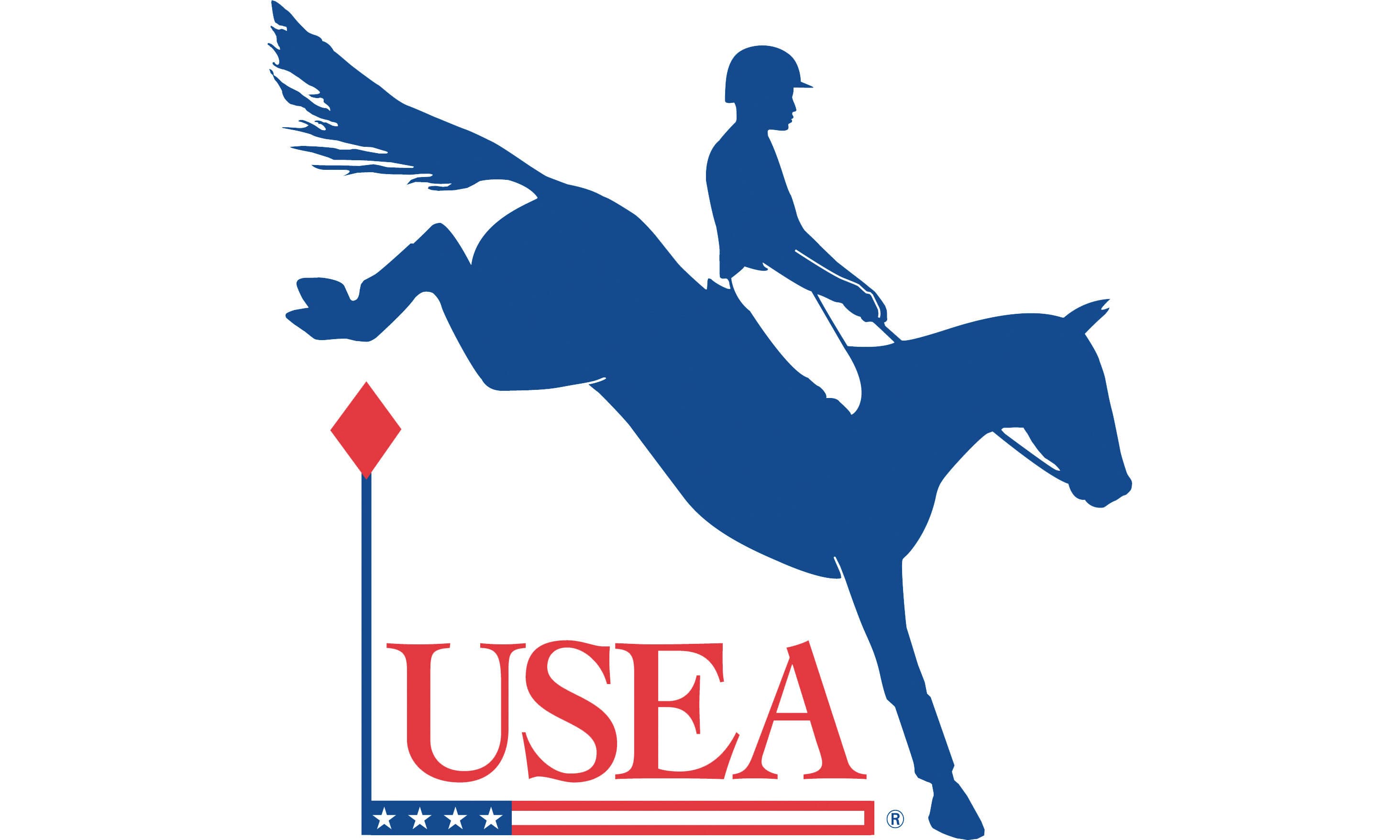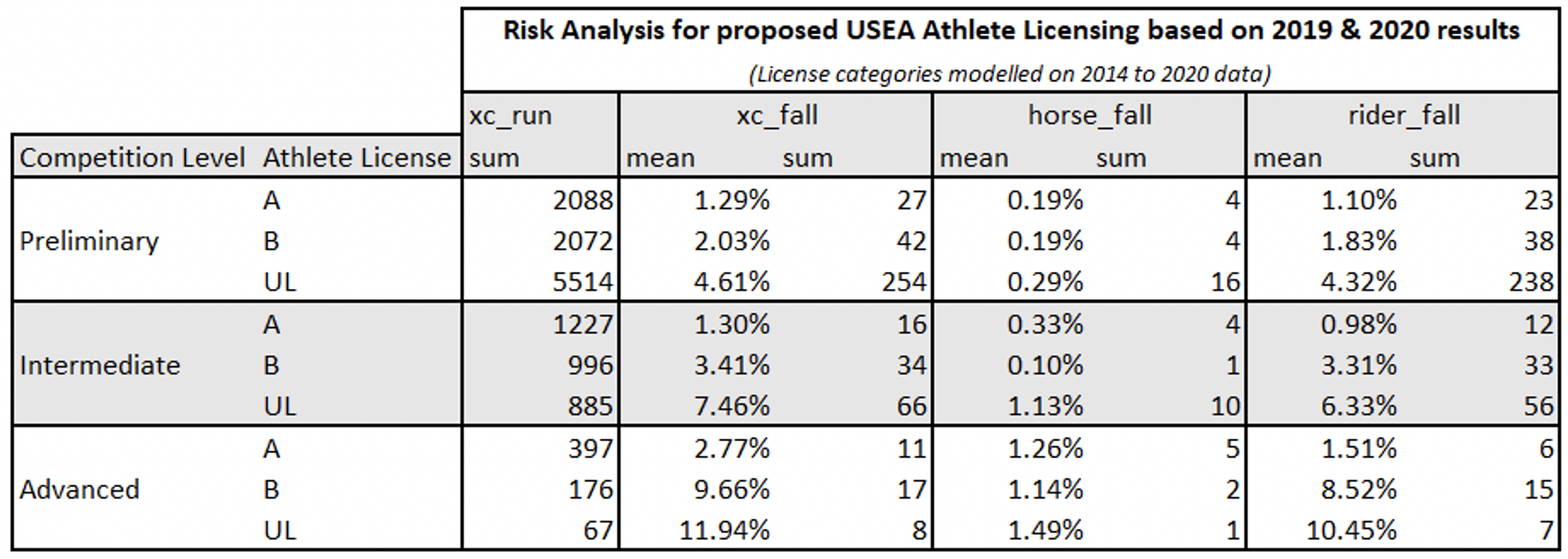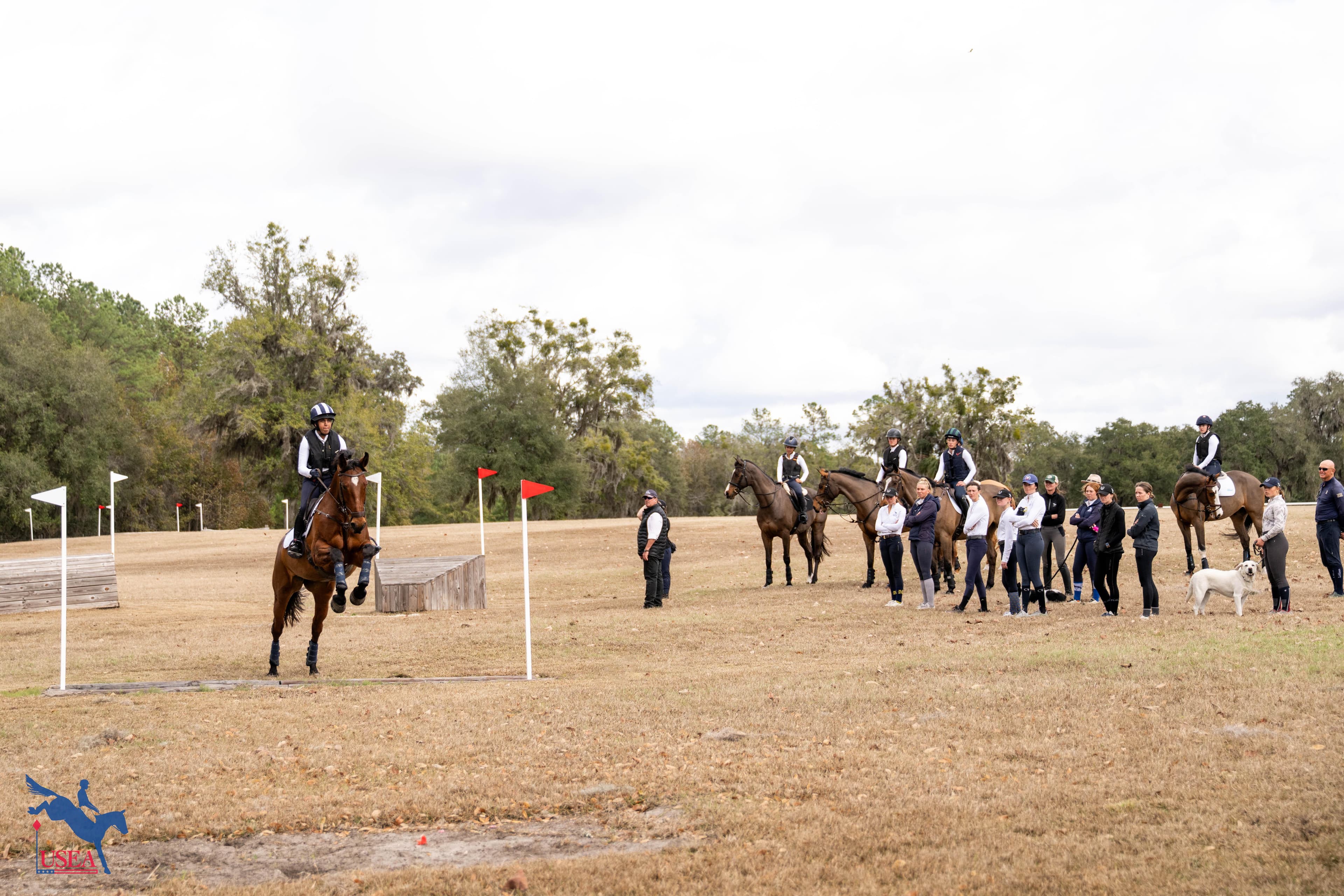Update on Appendix 3 Rule Change Proposal

Updated March 1 at 10:45 a.m. ET. with the removal of EV105. Please remember to fill out the survey to provide feedback.
Following feedback from our membership to the rule change proposal for the USEF Rules For Eventing: Appendix 3 – Participation In Horse Trials, the United States Eventing Association (USEA) Board of Governors voted to modify the rule change proposal, but still to recommend the establishment of rider licenses and increase Minimum Eligibility Requirements (MERs) to the regulating authority of the sport US Equestrian (USEF).
The USEA Cross-Country Safety Subcommittee developed the original proposal after a review of serious injuries and fatalities in the sport. The consensus of the group was that the standards needed to be raised to earn the right to move into a higher level of competition. The MER numbers were based on best practices of top-level competitors in the sport as well as data analysis supported by the independent firm EquiRatings. The proposal passed from the Subcommittee to the USEA Board of Governors who made the decision to lower the requirements before it moves to US Equestrian (USEF).
Jonathan Holling, chair of the USEA Cross-Country Safety Subcommittee, spoke to the Board of Governors to explain further the proposal. “All of the officials I have spoken to agree that something needs to change,” said Holling. “When we came out last year with the frangible fence initiative one of the big things that was said to me early on and repeated loud and clear was that 'this is great, this is wonderful, but it isn’t going to solve the problem by itself.’ We need better riding through better qualifications, better coaching – all of it. While we realize that frangible fences are a huge piece of this, we have to have some sort of a rider license and increasing the qualifications going forward. I know that there have been some concerns about Areas that don’t have as many events and I hear you loud and clear, but just know on this committee there are a lot of people that come from all over this country – I am from Milwaukee, Wisconsin, we have Canadians, we have west coasters. The reality is that we have a responsibility to the sport of eventing to do the best we can to make it as safe as possible and I firmly believe this proposal we are putting in front of [the Board] does that.”
Dave Vos, member of the USEA Cross-Country Safety Subcommittee, an amateur eventer, and a highly experienced engineer, joined the call to explain the numbers and data collected by EquiRatings to the Board. “The statistics tell you what the picture is, and they tell us that we need to reduce the fall rate and therefore reduce the risk of serious falls happening,” said Vos. “While addressing risk is the main driver, we are also addressing the quality of riding throughout eventing in the United States and that goes very much hand in hand with additional experience, additional expertise, and additional training in order to move up the ranks. You build a much better foundation if you are way more proficient at Training before you go to Preliminary and so on. Where we are is that the numbers aren’t crazy different from what people are already doing, but they do encourage additional experience and training.”

Based on the data prepared the following can be noted:
- Preliminary level: Unlicensed riders (55% of all entries) are falling at a rate of 4.6%, compared to B riders (23% of all entries) at 2%, and A riders (22% of all entries) at 1.3%.
- Intermediate level: Unlicensed riders (30% of all entries) are falling at a rate of 7.5%, compared to B riders (30% of all entries) at 3.4%, and A riders (40% of all entries) at 1.3%.
- Advanced level: Unlicensed riders (10% of all entries) are falling at a rate of 12%, compared to B riders (30% of all entries) at 10%, and A riders (60% of all entries) at 2.8%.
The estimate of conditional probability of a fall given the new licenses yields:
- Likelihood of a fall at Preliminary given rider is unlicensed =1/(4.6/100)/(55/100) = 1 in 39
- Likelihood of a fall at Preliminary given rider is a B =1/(2/100)/(23/100) = 1 in 217
- Likelihood of a fall at Preliminary given rider is an A =1/(1.3/100)/(22/100) = 1 in 349
Before moving up to the Preliminary level riders are currently completing on average:
- Unlicensed riders: 6 MERs (with a +/- 4 standard deviation)
- B riders: 5 MERs (with a +/- 4 standard deviation)
- A riders: 4 MERs (with a +/- 3 standard deviation)
So, a good number are already achieving the new requirements.
Rule change proposals from breeds and disciplines are due to the USEF by March 1, 2021. The proposal will then be subject to an internal review from the USEF’s Legal Department and an open comment period for USEF committees, members, and affiliates will then be available from March 16 to April 15. The USEF Board of Directors will then consider the proposal at the USEF Summer Board meeting and if it passes it will be implemented on December 1, 2021, for the 2022 eventing season. Throughout the process, the USEA Board of Governors will continue to listen to feedback as well as evaluate the proposal and retains the option to recommend further changes.
The rule change proposal would establish a licensing of riders (similar to the FEI categorization) as well as increase the number of MERs required for riders to compete at the Preliminary, Intermediate, and Advanced levels.
The wording of the rule change proposal being sent to the USEF is as follows: (bold indicates proposed change to current rule). The original rule change proposal can be viewed at this link.
Appendix 3 – Participation In Horse Trials, Rule Change Proposal;
Proposed Effective Date Dec. 1, 2021
Origination: USEA Cross-country Safety Subcommittee
A competitor and/or a horse may be entered in a Horse Trial without having fulfilled the qualifications noted below, provided the qualifications have been fulfilled at least 10 days before the Cross-Country Test of the competition for which it is needed if the MER has been achieved at a Horse Trial or CCI-S or at least 24 days if the MER has been achieved at a CCI-L. For Preliminary, Modified, and Training Classic Three-Day Events, qualifying competitions must be completed within a 24-month period of the start of the competition. At the CCI* level and above, at least one MER must be obtained in the twelve month period prior to the competition. e.g. a horse and/or rider who have achieved a MER at a CCI4* level of competition National levels at preliminary and above, at least one of the required results must have been obtained within eight weeks prior to the competition.
1. SECTIONS – Remain as written. This section will be included when the proposed language is entered into the USEF Rule Portal.
2. DEFINITIONS
2.1 Completion: means having completed the entire Horse Trial with a numerical score.
2.2 Minimum Eligibility Requirement
2.2.1 When achieved at a National Horse Trials an MER is achieved by completing the entire Horse Trial and scoring. -not more than 50 penalty points in the Dressage Test; and - No jumping penalties at obstacles on the Cross Country Test unless specified otherwise, and not more than 90 seconds (36 penalty points) exceeding the optimum time; and - not more than 16 penalties at obstacles in the Jumping Test. -25 penalty points received for Dangerous Riding will not achieve a National Qualifying result. Exceptions to the qualifications noted below may only be approved by the Credentials Committee.
2.2.2 When achieved at an FEI Competition an MER is achieved by completing the entire Horse Trial and scoring. -not more than 45 penalty points in the Dressage Test; and - No jumping penalties at obstacles on the Cross Country Test unless specified otherwise, and not more than 75 seconds (30 penalty points) exceeding the optimum time for one, two, three, and four star competitions and 100 seconds (40 penalty points) exceeding the optimum time for five star competitions; and - not more than 16 penalties at obstacles in the Jumping Test (see Article 517 of the FEI Eventing Rules).
2.3 FEI Uncategorized Rider: Riders who have not been categorized through proven competence at certain levels of competition i.e. A rider, B riders, etc. by the FEI per Article 520 of the FEI Eventing Rules for the purpose of determining rider eligibility for International Horse Trials and Events. All requirements of the FEI must be achieved as a combination. When multiple Minimum Eligibility Requirements are required by the FEI, one of the Minimum Eligibility Requirements can be achieved incurring 20 penalties at the obstacles of the Cross Country Test. All USEF requirements do not need to be achieved as a combination.
2.4 FEI Categorized Riders: Riders who have been categorized through proven competence at certain levels of competition A riders, B riders, etc. by the FEI per Article 520 of the FEI Eventing Rules for the purpose of determining rider eligibility for International Horse Trials and Events. When multiple Minimum Eligibility Requirements are required, one of the Minimum Eligibility Requirements can be achieved incurring 20 penalties at the obstacles of the Cross Country Test. All USEF requirements do not need to be achieved as a combination.
A competitor and/or a horse may be entered in a Horse Trial without having fulfilled the qualifications noted below, provided the qualifications have been fulfilled at least 10 days before the Cross-Country Test of the competition for which it is needed if the MER has been achieved at a Horse Trial or CCI-S or at least 24 days if the MER has been achieved at a CCI-L.
For Preliminary, Modified, and Training Classic Three-Day Events, qualifying competitions must be completed within a 24-month period of the start of the competition. At the CCI* level and above, at least one MER must be obtained in the twelve month period prior to the competition. e.g. a horse and/or rider who have achieved a MER at a CCI4* level of competition. National levels at preliminary and above, at least one MER must have been obtained within eight weeks prior to the competition.
3. LEVELS OF HORSE TRIALS AND EVENTS
3.1 BEGINNER NOVICE (B) – Open to competitors of any age, on horses four years of age and older.
3.2 NOVICE (N) – Open to competitors of any age, on horses four years of age and older.
3.3 TRAINING (T) – Open to competitors of any age, on horse four years of age and older.
3.4 MODIFIED (M) – Open to competitors of any age, on horse four years of age and older. The competitor must have obtained an MER at the Training Level or higher.
3.5 TRAINING CLASSIC THREE-DAY EVENT- Open to competitors of any age, on horses four years of age or older. Both the competitor and the horse as a combination must have obtained MERs at three Horse Trials at the Training Level or higher, plus an additional MER at the Training Level or higher with no more than 20 jumping penalties at obstacles on the Cross Country test. A competitor established at the Preliminary Level may compete on a horse which has obtained 2 MERs at the Training Level or higher within 24 months of the competition.
3.6 MODIFIED CLASSIC THREE-DAY EVENT – Open to competitors of any age, on horses five years of age or older. Both the competitor and the horse as a combination must have obtained MER’s at three Horse Trials at the Training Level or higher, plus an additional MER at Modified Level or higher with no jumping penalties at obstacles on the Cross-Country test within 24 months of the competition. A competitor established at the Preliminary Level may compete on a horse which has obtained two MERs at the Training Level or higher within 24 months of the competition
4. LICENSED RIDERS – NATIONAL COMPETITIONS. USEF Rider Licenses define a recognition of proven competence of the Competitor at a certain level. Competitors will be categorized as: Licensed National (A), Licensed B National(B) and Unlicensed National (UL). The license level will be updated according to performance on the 1st of July and at the end of each calendar year considering the rolling previous 8 years.
4.1 License “A” – Competitors will have obtained 25 MER results at the Intermediate Horse Trials level and above, or FEI Categorized C. This can be at any mix of USEF Horse Trials or FEI CCI (S or L).
4.2 License “B” – Competitors will have obtained 25 MER results at the Preliminary Horse Trials level and above, or FEI Categorized D. This can be at any mix of USEF Horse Trials or FEI CCI (S or L).
4.3 Unlicensed “UL” – All other Competitors will be categorized as Unlicensed.
5. PRELIMINARY (P) – Open to competitors from the beginning of the calendar year of their 14th birthday on horses five years of age or older. “A” competitors must have obtained an MER at four Horse Trials at the Training Level or higher. “B” competitors and the horse, as a combination, must have obtained an MER at four Horse Trials at the Training Level or higher, plus two additional MER at the Training Level or higher with no more than 20 Jumping Penalties at obstacles on the Cross Country test. “UL’ competitors and the horse, as a combination, must have obtained an MER at six Horse Trials at the Training Level or higher, plus two additional MER at the Training Level or higher with no more than 20 Jumping Penalties at obstacles on the Cross Country test.
5.1 PRELIMINARY CLASSIC THREE-DAY EVENT – Open to competitors beginning the calendar year of their 14th birthday, on horses five years of age or older. Both the competitor and the horse, as a combination must have obtained an MER at three Horse Trials at the Preliminary Level or higher, at obstacles plus an additional MER at the Preliminary Level or higher with no more than 20 Jumping Penalties on the Cross Country test.
5.2 INTERMEDIATE (I) – Open to competitors from the beginning of the calendar year of their 16th birthday, on horses six years of age or older. “A” competitors and the horse, though not necessarily as a combination, must have obtained an MER at three Horse Trials at the Preliminary Level or higher, plus an additional MER at the Preliminary Level or higher with no more than 20 Jumping Penalties at obstacles on the Cross Country test. “B” competitors and the horse, as a combination, must have obtained an MER at four Horse Trials at the Preliminary Level or higher, plus two additional MER at the Preliminary Level or higher with no more than 20 Jumping Penalties at obstacles on the Cross Country test. “UL” competitors and the horse, as a combination, must have obtained an MER at six Horse Trials at the Preliminary Level or higher, plus two additional MER at the Preliminary Level or higher with no more than 20 Jumping Penalties at obstacles on the Cross Country test.
5.3 ADVANCED (A) – Open to competitors from the beginning of the calendar year of their 18th birthday, on horses six years of age or older. “A” competitors and the horse, though not necessarily as a combination, must have obtained an MER at three Horse Trials at the Intermediate Level or higher, plus an additional MER at the Intermediate Level or higher with no more than 20 Jumping Penalties at obstacles on the Cross Country test. “B” competitors and the horse, as a combination, must have obtained an MER at four Horse Trials at the Intermediate Level or higher, plus two additional MER at the Intermediate Level or higher with no more than 20 Jumping Penalties at obstacles on the Cross Country test. “UL” competitors and the horse as a combination, must have obtained an MER at six Horse Trials at the Intermediate Level or higher, plus two additional MER at the Intermediate Level or higher with no more than 20 Jumping Penalties at obstacles on the Cross Country test.
6. LEVELS OF INTERNATIONAL HORSE TRIALS AND EVENTS
6.1 4.1 UNCATEGORIZED RIDERS Listed below are the USEF requirements to compete in an FEI Competition. Additionally, all horses and riders must meet the minimum eligibility requirements (MER) published by the FEI which must be achieved by competitor and horse as a combination. Where FEI requirements refer to a “CCI” this may be satisfied by achieving an MER at a CCI-L or CCI-S of the level stated. When multiple MERs are required, one of the Minimum Eligibility Requirements can be achieved incurring 20 penalties at the obstacles of the Cross Country Test. All USEF requirements do not need to be achieved as a combination.
*At the CCI1 2* level and above, at least one MER must be obtained in the twelve-month period prior to the competition. e.g. a horse and/or rider who have achieved a MER at a CCI4* level of competition and who have not competed for over twelve months must first achieve a MER at the next lowest height level.
We want to hear from you and relate your thoughts regarding the new adapted proposal. Please fill out this survey to register your opinion on the proposal as updated by the USEA Board of Governors.














